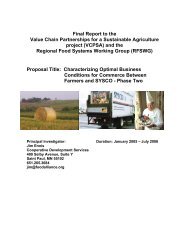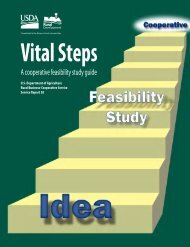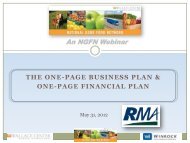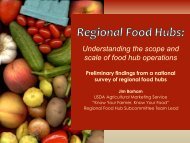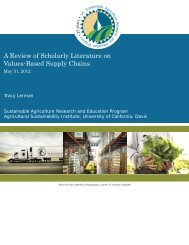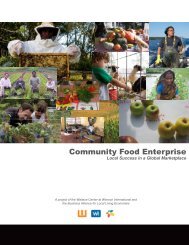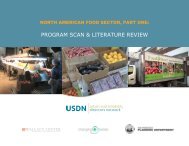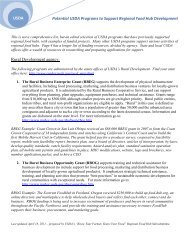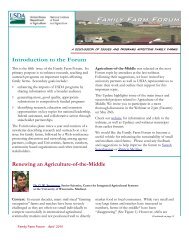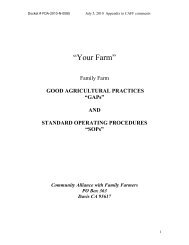The Common Market Feasibility Study - Agricultural Marketing Service
The Common Market Feasibility Study - Agricultural Marketing Service
The Common Market Feasibility Study - Agricultural Marketing Service
You also want an ePaper? Increase the reach of your titles
YUMPU automatically turns print PDFs into web optimized ePapers that Google loves.
THE COMMON MARKET FEASIBILTY STUDYIntroduction21IntroductionIn both Philadelphia and around the United States, there has been an increasing awareness of thebenefits of and demand for locally grown food. Purchasers of "local foods" realize a value and benefit infreshness and regional flavor; a sense of food security and support for the regional economy. Yetdespite the rising demand for local and regionally produced farm products, many would be purchaserscite an inability to reliably and/or affordably source it. Numerous studies indicate that sufficient marketdemand exists to support local and regional supply; however there is a lack of distribution infrastructureto support wholesale sales volumes. This in turn limits the amount of locally produced farm food thatfinds its way to consumers outside of the fragmented, direct farmer-to-consumer retail sales of farmmarkets, community supported agriculture and small-scale direct wholesale to restaurants. <strong>The</strong>importance of these efforts cannot be underestimated since the growing market demand for wholesalequantities of local products comes as a result of these direct retail efforts. When locally-grown productdoes make it through the wholesale distribution system for consumption in a local market, rarely does itmaintain the identity of the source farm nor is it differentiated as a locally produced item.<strong>The</strong> vision for the <strong>Common</strong> <strong>Market</strong> grew out of a collective desire to affect these supply constraintswhile simultaneously improving both the viability of local farmers and the food security ofPhiladelphians. Low-income urban and rural farm communities often bear the brunt of the fragmented,inefficient and unsustainable regional food system in the Philadelphia metropolitan area. Despite beingclose to some of the richest farmland in America, access to locally grown food is extremely limited formost Philadelphians. Likewise, area farmers are adjacent to the third largest market for food in the USyet many struggle to earn an adequate income due to the dominant, conventional distribution systemthat favors product from global competitors. <strong>The</strong> <strong>Common</strong> <strong>Market</strong> is a proposed solution to thismarket inefficiency as a means to enhance regional food self-reliance by creating an efficient local fooddistribution infrastructure that will connect local farmers to urban communities.Many Pennsylvania growers do not operate on a scale that enables them to devote adequate resourcesto transportation and sales at their individual farming operations. This, in turn, inhibits their access tothe mainstream distribution network. Furthermore, many local and regional farmers are producing fooditems that are in high demand but the mainstream food distribution network will not handle them dueto their scale, issues of seasonality, and the perceived risk involved. This includes items such as rawdairy products and heirloom and traditional produce varieties that do not ship well. Where localfarmers do participate in the large-scale wholesale market, a given farm and its products identity arerarely maintained. This leads to a farm-side loss of potential earnings due to unrealized margins and lostmarketing opportunities. <strong>The</strong> <strong>Common</strong> <strong>Market</strong> seeks to serve the needs of the region's farmers bysupplying consolidated sales and transportation support while expanding the reliability and ease ofaccess to locally grown products for the city's consumers. Underserved urban communities will alsobenefit through linkages to low cost, nutrient rich, in-season glut production.



